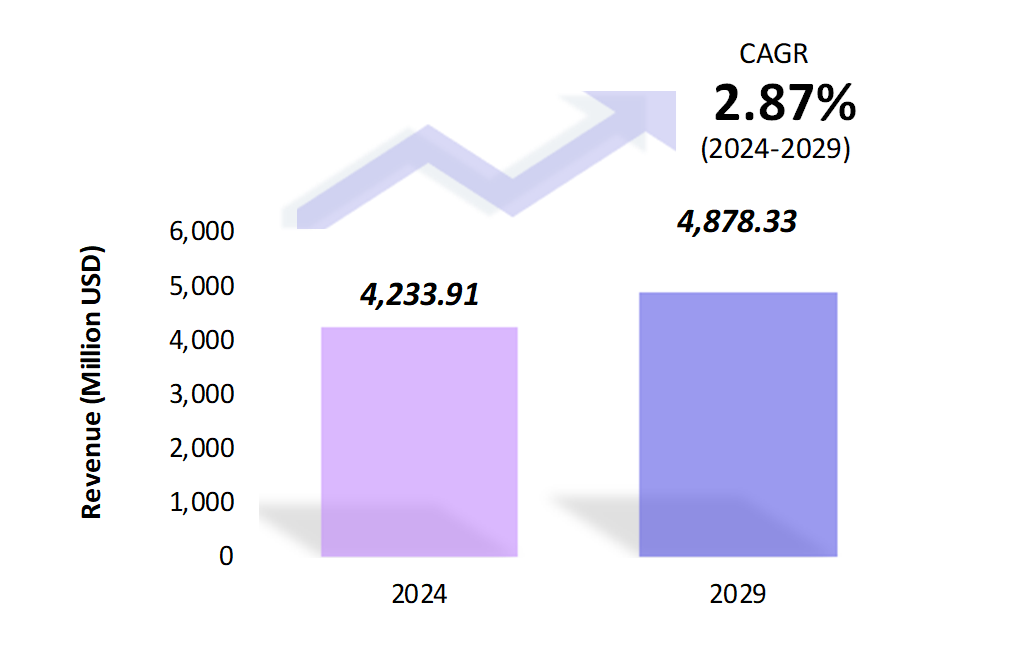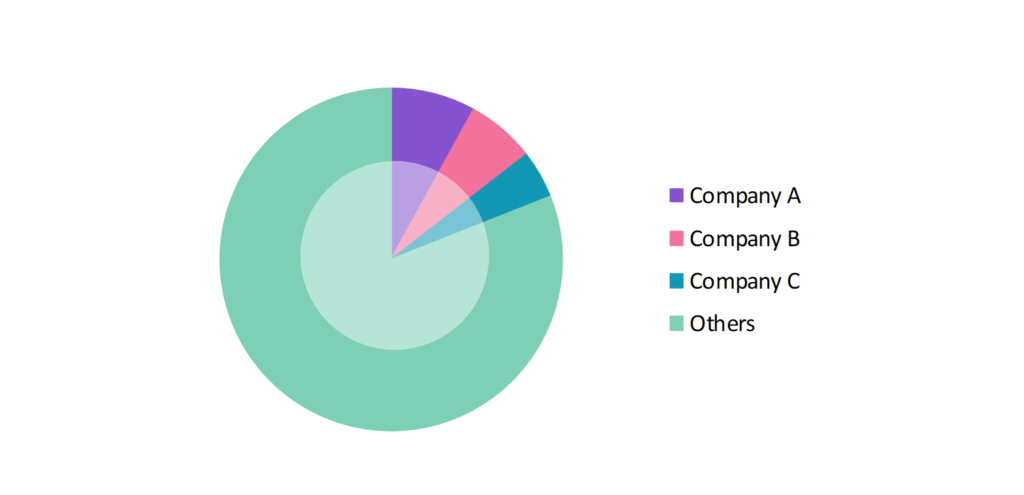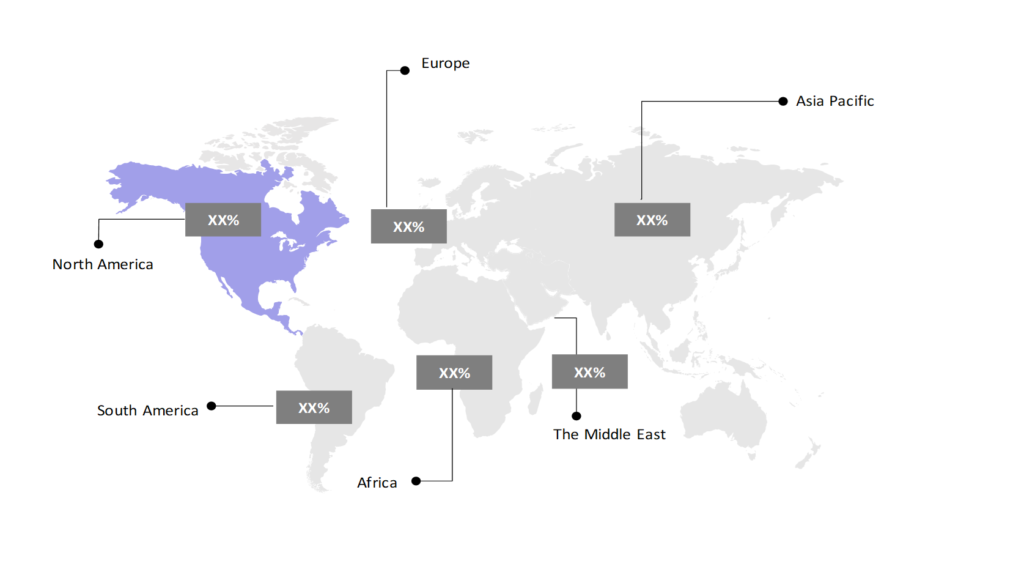Antivirus Software Market Outlook: Size, Share, Trends & Growth Analysis (2024-2029)
The market report presents a thorough analysis segmented by Device (Laptops, Desktops, Others); by Operating System (Windows, MAC, Android, Others); by End User (Personal, Corporate, Government, Others); by Geography (North America, South America, Asia Pacific, Europe, The Middle East, Africa).
Outlook

- The antivirus software market is estimated to be at USD 4,233.91 Mn in 2024 and is anticipated to reach USD 4,878.33 Mn in 2029.
- The antivirus software market is registering a CAGR of 2.87% during the forecast period of 2024-2029.
- The global antivirus software market growth is driven by the increasing prevalence of cyber threats and the growing need for cybersecurity solutions across various sectors.
Request a free sample.
Ecosystem

- The participants in the global antivirus software industry dominate the market through continuous innovation, brand reputation, and extensive distribution networks.
- These companies primarily invest in artificial intelligence (AI) and machine learning (ML) to improve threat detection capabilities, along with strategic alliances and partnerships to enhance their product offerings to maintain a competitive edge in the market.
- Several important entities in the antivirus software market include Adaware Software; AhnLab, Inc.; Avast Software s.r.o.; AVG; S.C. Bitdefender S.R.L.; and others.
Ask for customization.
Findings
| Attributes | Values |
|---|---|
| Historical Period | 2018-2022 |
| Base Year | 2023 |
| Forecast Period | 2024-2029 |
| Market Size (2024) | USD 4,233.91 Mn |
| Market Size (2029) | USD 4,878.33 Mn |
| Growth Rate | 2.87% CAGR from 2024 to 2029 |
| Key Segments | Device (Laptops, Desktops, Others); Operating System (Windows, MAC, Android, Others); End User (Personal, Corporate, Government, Others); Geography (North America, South America, Asia Pacific, Europe, The Middle East, Africa) |
| Key Vendors | Adaware Software; AhnLab, Inc.; Avast Software s.r.o.; AVG; S.C. Bitdefender S.R.L. |
| Key Countries | The US; Canada; Mexico; Brazil; Argentina; Colombia; Chile; China; India; Japan; South Korea; The UK; Germany; Italy; France; Spain; Turkey; UAE; Saudi Arabia; Egypt; South Africa |
| Largest Market | North America |
Get a free quote.
Trends
- Use of Artificial Intelligence (AI) and Machine Learning (ML): AI and machine learning are being increasingly integrated into antivirus software to enhance threat detection. In 2023, Avast launched an AI-driven feature that predicts and mitigates potential threats before they become active, showcasing the industry’s move towards more proactive security measures.
- Zero-Day Threat Protection: Zero-day threat protection is becoming a critical focus in the antivirus software market. This advanced security approach aims to defend against previously unknown vulnerabilities and exploits, often using AI and machine learning to identify and mitigate potential threats before they can be widely exploited.
- Cloud-Based Antivirus Solutions: A trend in the market is the shift towards cloud-based antivirus solutions. These systems leverage cloud computing to offload resource-intensive scanning and analysis tasks from local devices, providing real-time protection without compromising device performance. In 2023, McAfee reported a 20% increase in its cloud-based antivirus subscriptions, driven by the need for scalable and flexible cybersecurity solutions in remote work environments.
Speak to analyst.
Catalysts
- Rising Cybersecurity Threats: The increasing frequency and sophistication of cyberattacks are driving the demand for antivirus software. In 2023, Colonial Pipeline was targeted by a ransomware attack, highlighting the critical need for robust antivirus solutions in protecting critical infrastructure.
- Proliferation of IoT Devices: The rising adoption of Internet of Things (IoT) devices, which are often vulnerable to cyberattacks, is driving the need for antivirus software. In 2023, Cisco reported a significant increase in IoT-related cyberattacks, leading to higher demand for antivirus solutions tailored to these devices.
- Regulatory Compliance Requirements: Stringent data protection regulations such as GDPR and CCPA are driving organizations to adopt antivirus software to ensure compliance. In 2023, British Airways faced a significant GDPR fine due to a data breach, prompting many companies to strengthen their cybersecurity measures.
Inquire before buying.
Restraints
- Complexity in Detecting Advanced Threats: With cybercriminals constantly evolving their techniques, antivirus software struggles to keep up with sophisticated attacks. In 2023, Trend Micro reported challenges in identifying fileless malware attacks, where malicious activity is executed in memory, bypassing traditional signature-based detection methods.
- Integrating with Legacy Systems: Integrating new antivirus software with legacy IT systems remains a challenge for many enterprises. In 2023, ABC Corporation experienced significant delays in deploying an updated antivirus solution due to compatibility issues with its outdated infrastructure, reflecting the technical hurdles in seamless integration.
- False Positive Induced Performance Issues: Antivirus software can sometimes flag legitimate programs as threats, leading to user frustration and inefficiency. In 2023, Norton had to issue multiple updates to address performance issues caused by false-positive detections that impacted productivity for enterprise users.
Personalize this research.
Hotspot

Explore purchase options.
Table of Contents
| 1. Introduction 1.1. Research Methodology 1.2. Scope of the Study 2. Market Overview / Executive Summary 2.1. Global Antivirus Software Market (2018 – 2022) 2.2. Global Antivirus Software Market (2023 – 2029) 3. Market Segmentation 3.1. Global Antivirus Software Market by Device 3.1.1. Laptops 3.1.2. Desktops 3.1.3. Others 3.2. Global Antivirus Software Market by Operating System 3.2.1. Windows 3.2.2. MAC 3.2.3. Android 3.2.4. Others 3.3. Global Antivirus Software Market by End User 3.3.1. Personal 3.3.2. Corporate 3.3.3. Government 3.3.4. Others 4. Regional Segmentation 4.1. North America 4.1.1. The US 4.1.2. Canada 4.1.3. Mexico 4.2. South America 4.2.1. Brazil 4.2.2. Argentina 4.2.3. Colombia 4.2.4. Chile 4.2.5. Rest of South America 4.3. Asia Pacific 4.3.1. China 4.3.2. India 4.3.3. Japan 4.3.4. South Korea 4.3.5. Rest of Asia Pacific 4.4. Europe 4.4.1. The UK 4.4.2. Germany 4.4.3. Italy 4.4.4. France 4.4.5. Spain 4.4.6. Rest of Europe 4.5. The Middle East 4.5.1. Turkey 4.5.2. UAE 4.5.3. Saudi Arabia 4.5.4. Rest of the Middle East 4.6. Africa 4.6.1. Egypt 4.6.2. South Africa 4.6.3. Rest of Africa 5. Value Chain Analysis of the Global Antivirus Software Market 6. Porter Five Forces Analysis 6.1. Threats of New Entrants 6.2. Threats of Substitutes 6.3. Bargaining Power of Buyers 6.4. Bargaining Power of Suppliers 6.5. Competition in the Industry 7. Trends, Drivers and Challenges Analysis 7.1. Market Trends 7.1.1. Market Trend 1 7.1.2. Market Trend 2 7.1.3. Market Trend 3 7.2. Market Drivers 7.2.1. Market Driver 1 7.2.2. Market Driver 2 7.2.3. Market Driver 3 7.3. Market Challenges 7.3.1. Market Challenge 1 7.3.2. Market Challenge 2 7.3.3. Market Challenge 3 8. Opportunities Analysis 8.1. Market Opportunity 1 8.2. Market Opportunity 2 8.3. Market Opportunity 3 9. Competitive Landscape 9.1. Adaware Software 9.2. AhnLab, Inc. 9.3. Avast Software s.r.o. 9.4. AVG 9.5. S.C. Bitdefender S.R.L. 9.6. Company 6 9.7. Company 7 9.8. Company 8 9.9. Company 9 9.10. Company 10 |
Know the research methodology.
Antivirus Software Market – FAQs
1. What is the current size of the antivirus software market?
Ans. In 2024, the antivirus software market size is USD 4,233.91 Mn.
2. Who are the major vendors in the antivirus software market?
Ans. The major vendors in the antivirus software market are Adaware Software; AhnLab, Inc.; Avast Software s.r.o.; AVG; S.C. Bitdefender S.R.L.
3. Which segments are covered under the antivirus software market segments analysis?
Ans. The antivirus software market report offers in-depth insights into Device, Operating System, End User, and Geography.
